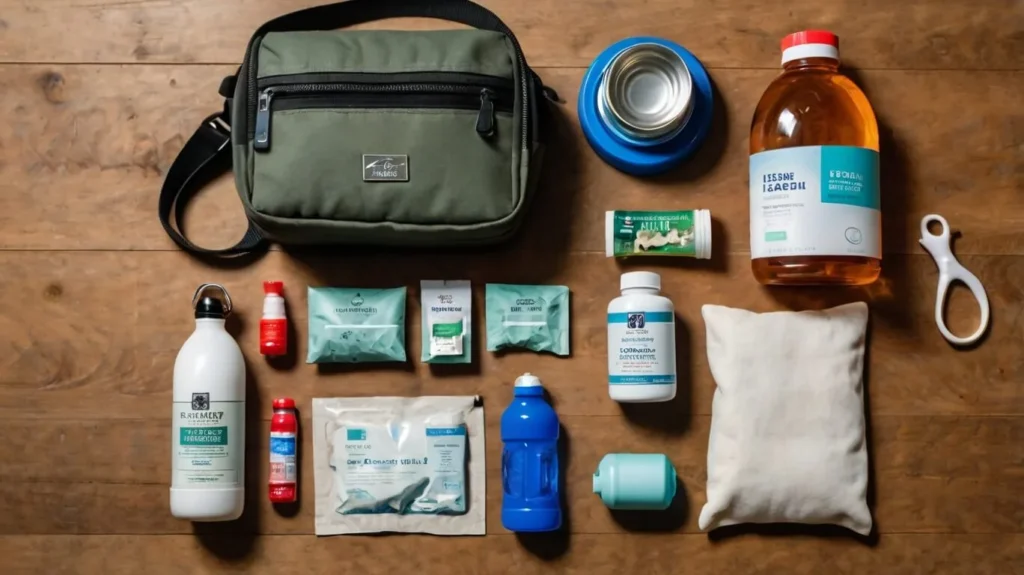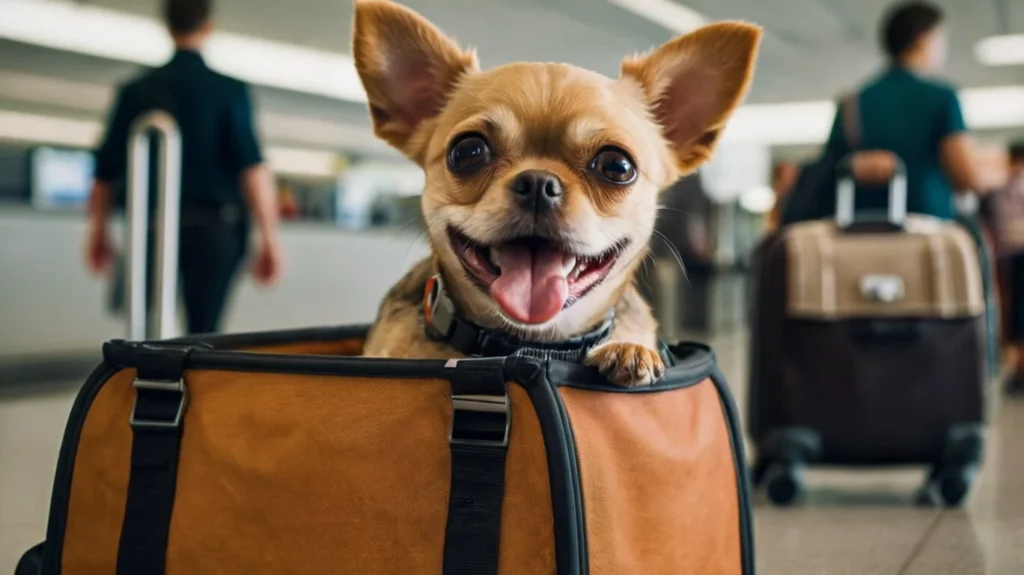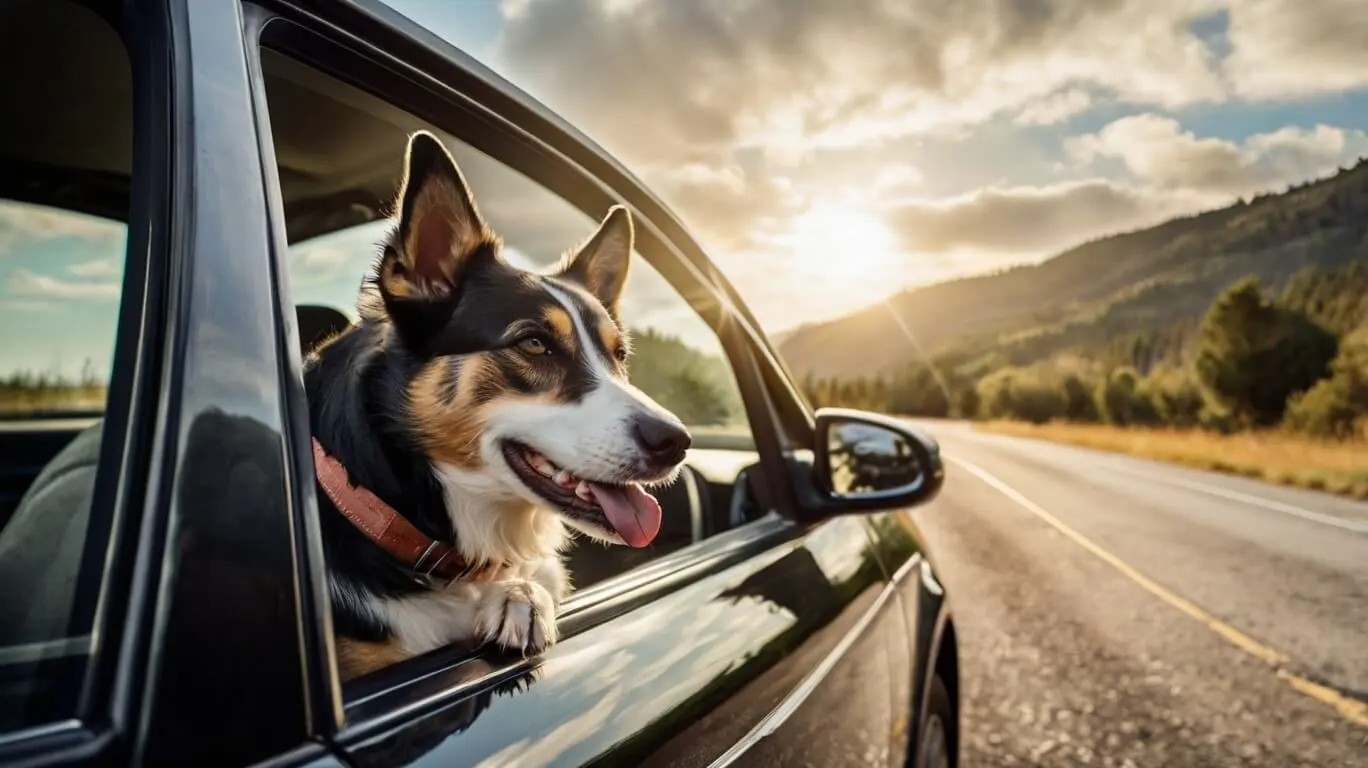Top 5 Best Ways to Travel with a Dog (Backed by Pet Experts)
Traveling with your dog can be one of the most rewarding experiences — but only if you plan it right. Whether you’re heading out on a road trip or flying across the country, knowing the best way to travel with a dog can make the difference between a smooth adventure and a stressful journey for both you and your furry friend.
From packing the right gear to understanding airline policies and finding pet-friendly accommodations, there’s a lot to consider. The good news? You don’t have to figure it out alone. In this post, we’ve gathered the top 5 expert-approved ways to travel safely and comfortably with your dog. Whether you’re a first-time traveler or a seasoned pet parent, these tips will help ensure your next trip is a tail-wagging success.
Let’s dive into the essentials every dog owner should know before hitting the road or skies.
Preparing Your Dog for Travel
🦴 Schedule a Pre-Travel Vet Visit
Before you set out on any adventure with your dog, scheduling a pre-travel visit to the veterinarian is absolutely essential. This step ensures your dog is healthy, safe, and ready to handle the stress and demands of travel—whether by car, plane, or train.
✅ Why It’s Important:
Travel can expose your dog to unfamiliar environments, temperature changes, and other animals, which may trigger health issues or anxiety. A vet visit will help you catch any underlying conditions that could worsen during the trip and make sure your dog is physically fit for travel.
📋 What to Discuss with Your Vet:
- Health Certificate: Many airlines and even hotels require a health certificate issued within 7–10 days of departure, verifying that your dog is up-to-date on vaccinations and free from contagious diseases.
- Vaccinations: Ensure your dog is current on core vaccines such as rabies, distemper, and Bordetella (especially important if you’re flying or staying at pet-friendly accommodations).
- Flea/Tick and Heartworm Prevention: Traveling to a different region may expose your pet to parasites not found in your area. Your vet can prescribe preventive medications.
- Motion Sickness and Anxiety: If your dog gets carsick or anxious during travel, ask about medications or natural calming aids like pheromone sprays or supplements.
- Microchipping: If your dog isn’t microchipped, now is the perfect time. If they are, ensure the contact information is up to date. A collar ID tag is great, but a microchip provides an extra layer of security.
🧳 Bonus Tip:
Ask your vet for copies of medical records and keep both digital and printed versions in your travel bag. This can be a lifesaver in case of emergencies or if you’re traveling internationally and need to show documentation at customs or vet checkpoints.

🎒 Pack the Essential Dog Travel Gear
One of the best ways to travel with a dog is to be fully prepared with the right gear. Just like humans need luggage, your dog also needs a personalized travel kit to ensure their comfort, safety, and well-being throughout the journey. Whether you’re hitting the road or catching a flight, packing the right essentials can make the trip smoother and more enjoyable for both of you.
🐶 Must-Have Travel Items for Your Dog:
- Crate or Carrier
Choose a crate that’s well-ventilated, sturdy, and airline-approved if you’re flying. For road trips, a crash-tested crate or seatbelt harness keeps your dog secure. A soft-sided carrier works well for small dogs traveling in-cabin on planes.
→ Tip: Familiarize your dog with the crate in advance to reduce stress. - Leash, Harness, and Collar with ID Tags
Always bring a sturdy leash and harness, especially for rest stops and bathroom breaks. Attach an ID tag with your contact info and consider a GPS tag for added safety. Don’t rely solely on collars—harnesses offer more control and reduce choking risks. - Collapsible Water & Food Bowls
Compact and lightweight, these are perfect for feeding your dog on the go. Look for spill-proof designs that are easy to clean. Staying hydrated is key, especially during summer travel or flights. - Portable Dog Bed or Blanket
Bringing something familiar from home can help ease travel anxiety. A travel bed or soft blanket can make hotel rooms, car seats, and crates feel more comfortable and safe. - Dog Food and Treats
Pack enough of your dog’s regular food for the entire trip to avoid tummy issues. Sudden diet changes can cause digestive upset. Also bring some favorite treats for rewards and positive reinforcement. - Poop Bags and Cleaning Supplies
Always be a responsible pet parent—pack plenty of waste bags, along with pet-safe wipes, paper towels, and a small disinfectant spray in case of accidents. - Toys and Chews
Keep your dog entertained during long drives or flights. Choose safe chews, puzzle toys, or calming toys that can help alleviate boredom and anxiety. - First-Aid Kit
Include items like gauze, antiseptic wipes, tweezers, and any necessary medications. Consider travel-specific kits available from Petco or Chewy.
📱 Pro Tip:
Use a checklist app or printable packing list to make sure you don’t forget anything. Apps like Pawtrack or BringFido can also help you locate pet stores and emergency vets during your trip.
Packing thoughtfully ensures that your dog’s physical and emotional needs are met—no matter how far you travel.
🧘 Train Your Dog for Travel Situations
Even the most well-behaved dogs can become anxious or overwhelmed in unfamiliar environments. That’s why one of the best ways to travel with a dog is to invest time in training before the trip. Proper preparation helps your dog feel confident, calm, and safe—making travel smoother for both of you.
🎯 Start with Crate Training
If your dog isn’t already crate-trained, start at least a few weeks before your trip. Whether you’re traveling by car or plane, a crate provides your dog with a safe, enclosed space and minimizes stress.
- Introduce the crate gradually: leave the door open, place treats and toys inside, and reward your dog for going in willingly.
- Avoid using the crate as punishment—make it a positive, relaxing place.
Tip: Use the same crate or carrier you’ll use during travel so your dog becomes familiar with its smell and feel.
🚗 Simulate the Travel Experience
Before the actual journey, simulate short trips to get your dog used to the motion and sounds of travel:
- Car rides: Take your dog on short drives that gradually increase in length. Make stops at fun locations like parks or trails to build positive associations.
- Crowded places: Visit pet-friendly stores, cafes, or events to help your dog get used to busy environments and loud noises.
- Airport-style training: Practice standing in lines, being in a crate for longer periods, or hearing loud announcements through your phone or speakers.
This kind of exposure training helps reduce travel anxiety in dogs and prepares them for common stressors.
🎓 Basic Obedience and Socialization
A well-trained dog is easier to manage during travel and less likely to get into trouble in public spaces.
- Reinforce basic commands like sit, stay, come, leave it, and heel.
- Practice leash walking around distractions to mimic crowded places like airports or hotels.
- Work on impulse control, especially if your dog is excitable around new people or other animals.
If your dog struggles with obedience or fear-based behaviors, consider enrolling in a class or hiring a certified trainer before your trip.
💡 Pro Tip:
Use positive reinforcement—praise, treats, and toys—to encourage desired behavior. The goal is to make travel feel like an adventure, not a punishment.
Road Trips: Best Practices for Car Travel
🛡️ Use a Crash-Tested Crate or Seatbelt Harness
When it comes to road trips, safety should always be your top priority—both for you and your dog. One of the best ways to travel with a dog by car is to secure them properly using a crash-tested crate or a certified seatbelt harness. Letting your dog roam freely inside the vehicle might seem harmless, but it can be dangerous and even life-threatening in the event of a sudden stop or accident.
🚙 Why Free-Roaming Is Risky
An unrestrained dog can become a serious distraction to the driver, increasing the risk of accidents. In a collision, your pet could be thrown from the seat or seriously injured—putting both of you in danger. Even a minor accident can cause trauma to an unsecured animal.
🧳 Crate vs. Harness: Which One Is Right for Your Dog?
✔️ Crash-Tested Crate
- Best for medium to large dogs or nervous travelers who feel more secure in a confined space.
- Look for crates made of reinforced plastic or aluminum, with proper ventilation and secure locks.
- Brands like Gunner, Impact Crates, and Sleepypod offer crash-tested models approved by the Center for Pet Safety (CPS).
- Secure the crate in the back seat or cargo area, ensuring it won’t slide or tip over during turns.
✔️ Seatbelt Harness System
- Ideal for smaller dogs or pets who prefer being near their owners.
- Attach the harness to your car’s seatbelt system—never use a collar alone, as it can cause choking or neck injuries.
- Choose a harness that has passed CPS crash testing (brands like Kurgo, Sleepypod Clickit Sport, and EzyDog Drive are popular).
- Avoid zipline or bungee-style tethers; they may offer mobility but fail to restrain your dog in a crash.
🛠️ Installation & Fit Tips
- Test the setup before the trip and let your dog get used to it in short rides.
- Ensure harnesses fit snugly but comfortably—tight enough to prevent slipping out, but not too tight to restrict breathing.
- Add a small blanket or mat inside the crate for extra comfort and stability.
🧠 Bonus Tip:
Always disable airbags in the front passenger seat if your dog is riding up front (only recommended for small dogs in carriers). Airbags can cause serious injury to pets in a crash.
Properly restraining your dog isn’t just about following safety recommendations—it’s about ensuring peace of mind for the entire journey. With the right setup, you can both enjoy the ride knowing your furry companion is secure and comfortable.
⏰ Plan Frequent Breaks and Potty Stops
One of the most important — and often overlooked — aspects of traveling with a dog is scheduling regular breaks. Whether you’re heading out on a weekend getaway or a cross-country adventure, dogs need frequent stops for potty breaks, hydration, stretching, and mental stimulation. When planning a road trip, frequent breaks aren’t just kind — they’re essential for your dog’s health, comfort, and happiness.
🚘 How Often Should You Stop?
As a general rule of thumb, plan to stop every 2 to 3 hours. This gives your dog a chance to:
- Go to the bathroom
- Drink water
- Stretch their legs
- Burn off some pent-up energy
For puppies, senior dogs, or pets with medical needs, you may need to stop even more frequently. Stopping often also reduces the risk of urinary tract infections and prevents behavioral issues caused by prolonged confinement.
🌳 Where to Stop with Your Dog
Not all rest areas are pet-friendly, so do a little research ahead of time to identify:
- Pet-friendly rest stops with designated dog walking zones
- Local parks or trails along your route
- Gas stations with open grassy areas
- Dog parks (use apps like BringFido or AllTrails to locate these)
Make sure the stop is safe from heavy traffic, loud noises, or harmful debris. Keep your dog on a leash at all times unless you’re in a secure, fenced-in area.
💩 Potty Etiquette and Cleanup
Responsible dog travel includes cleaning up after your pet. Always pack:
- Plenty of poop bags
- Pet-safe disinfectant wipes
- Hand sanitizer
- A small trash bag in case there’s no nearby disposal bin
Leaving messes behind is not only inconsiderate—it can lead to fines in some areas and reflects poorly on all pet travelers.
💧 Bonus Tip: Hydration Matters
Bring a portable water bottle or collapsible bowl and offer water at every stop. Dogs can get dehydrated quickly in warm weather or confined spaces, even when the A/C is running.
Taking frequent, thoughtful breaks is one of the simplest but most effective ways to keep your dog relaxed and healthy during your journey. It transforms your road trip into a series of mini-adventures, making the ride more enjoyable for everyone.
😌 Prevent Travel Anxiety
Traveling can be exciting for humans—but for dogs, it can be a confusing and overwhelming experience. Loud noises, unfamiliar environments, motion sickness, and separation from familiar routines can all trigger travel anxiety in dogs. That’s why one of the best ways to travel with a dog is to proactively help them feel calm, secure, and reassured before and during the journey.
🧠 Recognize the Signs of Travel Anxiety
Understanding your dog’s stress signals is the first step. Common signs include:
- Excessive panting or drooling
- Whining, barking, or howling
- Pacing or restlessness
- Shaking or trembling
- Refusing to eat or drink
- Vomiting or diarrhea
If your dog exhibits any of these symptoms, it’s essential to take preventative steps to reduce their discomfort.
🐾 Ways to Calm a Nervous Dog Before and During Travel
- Gradual Desensitization
Help your dog build positive associations with travel by introducing it gradually:- Let them explore the car while it’s parked.
- Start with short rides and increase the duration slowly.
- Reward calm behavior with treats, praise, or their favorite toy.
- Play relaxing music or use white noise to reduce sensory overload.
- Exercise Before You Travel
A tired dog is usually a calmer traveler. Take your dog for a brisk walk or play fetch before you hit the road or head to the airport. Physical activity helps release pent-up energy and reduces anxiety. - Use Comfort Items
Familiar scents and textures can have a grounding effect on dogs. Pack:- A favorite toy or chew
- A worn T-shirt that smells like you
- Their usual blanket or bedding for the crate
These familiar items offer comfort and a sense of “home” during unfamiliar experiences.
- Try Natural Calming Aids
For mild to moderate anxiety, many pet parents find relief with:- Pheromone sprays (like Adaptil)
- CBD oil or calming chews (vet-approved)
- Pressure wraps (like the Thundershirt)
- Herbal supplements with chamomile or valerian root
Always test these products before travel and consult your vet to ensure they’re safe and effective for your dog.
- Medication for Severe Cases
If your dog suffers from severe travel anxiety, consult your veterinarian. Prescription anti-anxiety medications or sedatives may be necessary for safe and humane travel, especially on long trips or flights.
🧘 Bonus Tip: Stay Calm Yourself
Dogs are incredibly sensitive to your emotions. If you’re stressed, your dog will pick up on it. Speak in a soothing tone, stay patient, and treat travel like an exciting adventure—not a stressful task. Your calm presence can make a huge difference in how your dog responds.
By preventing travel anxiety before it starts, you’ll set the stage for a smoother, safer, and more enjoyable experience. A confident, relaxed dog means a happy traveler—and a much better trip for both of you.

Flying with Your Dog: What You Need to Know
✈️ Understand Airline Pet Policies
Flying with your dog can be a convenient way to cover long distances, but it’s essential to understand and follow airline pet policies before booking your ticket. Every airline has its own rules regarding pet travel, and failing to follow them can result in denied boarding or even harm to your pet. One of the best ways to travel with a dog by air is to plan ahead, be informed, and ensure your dog meets all the airline’s requirements.
📋 Types of In-Flight Pet Travel
Most airlines offer one or more of the following options, depending on your dog’s size and breed:
- In-Cabin Travel
Small dogs (typically under 15–20 pounds including their carrier) may be allowed to travel in the cabin with you, under the seat in front of you.- Requires an airline-approved soft-sided carrier.
- The carrier must fit under the seat and allow your dog to stand, turn around, and lie down comfortably.
- You must remain responsible for your dog at all times—no taking them out of the carrier during the flight.
- Checked Baggage (Cargo Hold)
Medium to large dogs may be required to travel in the cargo hold as checked baggage.- This is temperature-controlled and pressurized but not as closely monitored as the cabin.
- Some breeds (like flat-faced dogs such as Pugs or Bulldogs) may be banned from cargo travel due to breathing risks.
- Crate must meet International Air Transport Association (IATA) standards.
- Manifest Cargo (Unaccompanied Pets or Special Arrangements)
Used when your pet is flying alone or needs specialized handling. Typically arranged through a pet relocation service or airline cargo department.
📝 Key Airline Pet Policy Factors to Review
- Pet fees: Ranges from $75 to $500 depending on the airline and method of transport.
- Breed restrictions: Some airlines ban certain dog breeds, especially snub-nosed or aggressive breeds.
- Temperature policies: Airlines may not allow pets in cargo during extreme weather (hot or cold).
- Age restrictions: Most airlines require pets to be at least 8–10 weeks old.
- Advance booking: In-cabin pet space is limited—reserve early to secure a spot.
- Health certificate: A recent veterinary certificate (typically within 10 days) is usually required.
📞 Pro Tip: Contact the Airline Directly
Even if you’ve read the online policy, it’s smart to call the airline in advance to confirm:
- Your specific flight allows pets.
- Your dog’s breed and size are accepted.
- There are no recent policy changes or travel restrictions (especially during holidays or peak seasons).
Some airlines with generally pet-friendly reputations include Alaska Airlines, JetBlue, American Airlines, and Delta, but always double-check specifics.
🧳 Bonus Tip: Prepare Your Dog for the Flight
- Get them used to the travel crate weeks before departure.
- Limit food and water a few hours before the flight (ask your vet for guidance).
- Attach clear identification, your contact details, and flight information to the crate or carrier.
Airline travel with a dog can be smooth and safe if you’re prepared and well-informed. By understanding and following airline pet policies, you’ll reduce stress and ensure a more comfortable journey for your furry travel companion.
👜 Choose the Right In-Cabin Carrier or Cargo Option
Selecting the right in-cabin carrier or cargo crate is one of the most crucial decisions when flying with your dog. Your pet’s comfort, safety, and the airline’s approval all hinge on choosing the appropriate travel container. To ensure a smooth and stress-free flight, you need to understand the differences between in-cabin pet carriers and airline-approved cargo crates, and select one that suits your dog’s size, temperament, and health.
🛩️ In-Cabin Carrier: For Small Dogs
If your dog is small enough to travel in the cabin (typically under 15–20 lbs including the carrier), you’ll need a soft-sided, airline-approved pet carrier that fits beneath the seat in front of you.
What to Look for:
- Size: Must meet the airline’s specific under-seat dimensions. Your dog should be able to stand up, turn around, and lie down comfortably.
- Material: Soft, breathable mesh panels for ventilation, durable zippers, and waterproof bottoms.
- Comfort: Add a soft mat or familiar blanket to reduce anxiety.
- Accessibility: Multiple openings for easy access at airport checkpoints.
Top Brands: Sherpa Original Deluxe, Sleepypod Air, and Petmate Soft-Sided Kennel Cab.
Pro Tip: Practice with the carrier at home and during short trips to help your dog acclimate before the flight.
📦 Cargo Crate: For Medium to Large Dogs
For dogs that are too big to fly in-cabin, a crash-tested, airline-approved hard crate is required for cargo travel.
Must-Have Features:
- Meets IATA Standards: Most airlines follow the International Air Transport Association (IATA) guidelines for cargo crates.
- Hard-Sided Shell: Rigid plastic or metal for structural integrity and protection.
- Secure Locking Mechanism: Latch systems that won’t open during turbulence or handling.
- Ventilation on at least 3 sides.
- Food/Water Dishes: Attached and accessible from outside the crate for handlers.
Top Brands: Vari Kennel, Sky Kennel by Petmate, Gunner G1 Crate (CPS-certified).
Important: Your dog should be able to sit, stand, turn around, and lie down without touching the crate’s top or sides.
✍️ Labeling and Documentation
Whether you’re using an in-cabin or cargo option, always label the carrier or crate with:
- Your name and contact information
- Dog’s name
- Flight details
- A “Live Animal” sticker (required for cargo)
Attach a small clear zip-lock pouch with copies of:
- Vaccination records
- Health certificate
- Feeding instructions (for long flights)
🧠 Bonus Tip: Safety First
Never sedate your dog before air travel without direct guidance from a vet—it can affect breathing and temperature regulation at high altitudes. Instead, focus on comfort, crate training, and natural calming aids if needed.
By choosing the right in-cabin carrier or cargo crate, you’re setting the foundation for a safe, comfortable, and airline-compliant travel experience for your dog. When your pet feels secure, they’re less anxious—and your journey becomes that much smoother.
🌍 Prepare for International Travel
Taking your dog abroad requires far more planning than domestic travel. Different countries have different rules, health requirements, and documentation standards for incoming pets. If you’re planning international travel with your dog, preparation is key to avoiding delays, quarantine, or outright denial of entry. One of the best ways to travel with a dog overseas is to start early and ensure every requirement is checked off well in advance.
🗓️ Start Planning Months Ahead
International pet travel is not something you can plan last minute. Start preparing at least 3–6 months before your departure, especially if your destination has strict pet import regulations (like the UK, Japan, Australia, or New Zealand).
Some countries require:
- Rabies vaccination done at least 21–30 days in advance
- Microchipping (ISO-compliant) before or at the same time as the rabies shot
- Blood titer test proving rabies antibody levels
- Parasite treatment (for ticks, tapeworms, etc.) within a specific timeframe
- Quarantine upon arrival (depending on risk level of originating country)
Use government sources or a pet travel agency to verify exact entry requirements for your destination country.
📄 Gather Essential Documents
Failure to provide complete documentation can result in serious consequences—like being denied entry or having your dog quarantined for weeks.
Key documents usually include:
- Valid rabies certificate (with date, manufacturer, batch number)
- Microchip certificate (must match the chip scanned at customs)
- Health certificate from an accredited vet, often within 10 days of travel
- Export permit or import license, depending on the country
- Titer test results (for rabies-free countries)
- Airline-specific fit-to-fly letter, if requested
Pro Tip: Always carry multiple copies, both physical and digital, in a travel folder. Some countries may ask for originals, and customs agents don’t always have access to printers.
🛫 Choose a Pet-Friendly Airline and Route
When flying internationally, not all airlines or routes are created equal. Look for airlines known for their pet-friendly policies and climate-controlled cargo holds. Some even offer “PetSafe” or “Live Animal” programs.
Consider:
- Flight duration: Nonstop flights are better for reducing stress
- Layovers: Avoid long or multiple stopovers, especially in countries with strict transit rules
- Arrival timing: Land during business hours when customs offices are open
Confirm your dog’s transport method (in-cabin vs. cargo) and ensure the crate meets international standards (IATA-compliant).
🏨 Check Entry Rules at Your Destination
Before you book accommodations:
- Ensure your hotel or rental is pet-friendly
- Check for breed restrictions, leash laws, or off-limit areas for pets
- Look into local vets, emergency clinics, or pet services nearby
For countries in the EU, consider applying for an EU Pet Passport (if eligible), which simplifies travel between member nations.
🧳 Packing Essentials for International Trips
Bring:
- Sufficient food (especially if your dog is on a special diet)
- Bottled water for the journey
- Familiar bedding and toys
- Medications with prescriptions
- Leash, harness, ID tags with international contact info
- Waste bags and cleaning wipes
International travel with a dog may seem complicated, but with careful preparation and early action, it’s completely manageable. Understanding health protocols, paperwork, and transportation logistics will make the experience smoother and safer for both you and your four-legged companion.
Dog-Friendly Destinations and Accommodations

🏨 Research Dog-Friendly Hotels & Rentals
Finding a comfortable and dog-friendly place to stay is essential for a smooth and enjoyable trip with your furry companion. Whether you’re planning a weekend getaway or a long vacation, your accommodation should cater to your dog’s needs just as much as your own. The best way to travel with a dog involves thoughtful planning—especially when it comes to where you’ll sleep, eat, and relax together.
🔍 Start Your Search with Pet-Friendly Booking Platforms
Fortunately, many travel websites now offer filters specifically for pet-friendly accommodations. Use these tools to narrow your options before you book.
Popular sites to find dog-friendly stays:
- BringFido – Dedicated to pet travel, offers real reviews and pet policies
- Airbnb – Use the “Pets allowed” filter to find dog-friendly rentals
- Booking.com – Offers a “Pet-friendly” filter under amenities
- Expedia and Hotels.com – Include pet policies in hotel descriptions
- Vrbo – A good option for private vacation homes that accept pets
Pro Tip: Even if a listing says “pets allowed,” always contact the host or hotel directly to confirm specific rules and fees for dogs.
📋 Check the Pet Policy Carefully
Not all “pet-friendly” stays are truly welcoming to dogs. Some may allow pets but impose heavy restrictions or fees. Before you book, ask the following:
- Is there a weight or breed limit?
- Are multiple dogs allowed?
- Is there an additional pet fee or deposit (refundable or non-refundable)?
- Can dogs be left alone in the room or rental?
- Are there designated dog walking or potty areas on-site?
- Do they offer dog beds, bowls, or treats?
Understanding these details in advance prevents surprise charges or uncomfortable situations when you arrive.
🛏️ Evaluate the Environment for Comfort & Safety
A truly dog-friendly accommodation should have more than just a “pets allowed” sign—it should be safe, comfortable, and enjoyable for your dog.
Look for:
- Non-carpeted flooring (easier to clean in case of accidents)
- Private entrance or fenced outdoor space (ideal for rentals)
- Nearby parks or walking paths
- Quiet surroundings (to reduce anxiety and barking triggers)
- Access to pet services, such as groomers, vets, or doggie daycare
For longer stays, a vacation rental may be preferable over hotels, giving your dog more room to roam and a homier atmosphere.
🐾 Look for Special Amenities & Extras
Some premium hotels and rentals go above and beyond with pet-friendly perks, such as:
- Complimentary dog treats or welcome kits
- On-site pet sitting or walking services
- Access to dog parks, agility courses, or pet spas
- Room service menus for dogs!
Chains known for pet-friendliness include:
- Kimpton Hotels – No size/breed restrictions and no pet fees
- Aloft by Marriott – Offers dog beds and treats
- La Quinta Inns & Suites – Most locations allow pets at no extra charge
By thoroughly researching dog-friendly hotels and rentals, you can ensure that your travel experience is relaxing, inclusive, and truly enjoyable for both you and your dog. When your pup feels safe and welcome, you’ll both sleep better and explore more happily.
🎾 Find Activities and Spaces Your Dog Will Enjoy
Traveling with your dog isn’t just about getting from place to place—it’s about making the journey fun and fulfilling for your furry companion too! To ensure a happy trip, one of the best ways to travel with a dog is to plan activities and find spaces where your dog can play, exercise, and socialize safely. This enriches your dog’s travel experience, helps burn off energy, and reduces stress and anxiety.
🐕🦺 Research Dog-Friendly Parks and Trails
Outdoor spaces are ideal for dogs to explore new scents and sights, stretch their legs, and burn off energy after a day of traveling.
- Dog parks: These fenced, off-leash areas are great for socializing with other dogs and letting your pup run freely. Check local regulations, hours, and any special rules (like vaccination requirements).
- Hiking trails: Many nature preserves and state parks welcome dogs on leash. Choose trails that match your dog’s fitness level and bring plenty of water.
- Beaches: If you’re near the coast, look for dog-friendly beaches where your dog can splash and play in the sand and surf. Be mindful of local rules about leash use and cleanup.
🐾 Explore Dog-Friendly Attractions and Events
Many cities and towns offer activities and attractions where dogs are welcome. From pet-friendly cafes and outdoor markets to festivals and dog-centric events, these experiences allow you and your dog to bond and enjoy new environments together.
- Pet-friendly restaurants and cafes: Some establishments offer outdoor seating with water bowls and even special dog menus.
- Dog-friendly tours: Some cities offer guided walking or boat tours that allow dogs, so you can explore local sights without leaving your pup behind.
- Dog events: Search for dog shows, meetups, or charity walks happening during your visit.
🦴 Find Dog-Friendly Amenities
Knowing where to find pet services during your trip can be a lifesaver. It’s smart to plan ahead by locating nearby:
- Veterinarians and emergency clinics
- Pet supply stores
- Dog grooming salons
- Dog daycare or boarding facilities
Having these resources on hand can ease your mind, especially if you’re staying longer or if your dog needs special care.
🌟 Plan for Playtime and Mental Stimulation
Travel can be tiring and stressful for dogs. Incorporate activities that engage your dog’s mind and body to keep them happy:
- Bring favorite toys for fetch or tug-of-war.
- Pack puzzle toys or treat-dispensing games to entertain your dog in your accommodation.
- Schedule downtime for quiet cuddling or gentle petting to help your dog relax.
By researching and planning dog-friendly activities and spaces, you make your travels enjoyable and enriching for your dog, creating lasting memories for both of you. A well-exercised, stimulated dog is a happy travel buddy—and a joy to have on any adventure.
📱 Use Helpful Apps for Pet Travelers
In today’s digital age, traveling with your dog has never been easier—thanks to a wide range of pet travel apps that help you stay organized, locate pet-friendly services, and keep your furry friend safe and happy on the road. Whether you need to find a nearby vet, book a pet-friendly hotel, or track your dog’s medical records, there’s an app for that.
Leveraging these tools is one of the best ways to travel with a dog efficiently and stress-free.
🧭 Navigation & Location-Based Pet Services
These apps help you find everything from dog parks to emergency vets:
- BringFido – One of the most popular apps for locating dog-friendly hotels, restaurants, attractions, and events. Includes reviews and booking options.
- Petlas – A map-based app showing nearby pet-related services like groomers, parks, vets, and pet stores.
- AllTrails – Perfect for discovering dog-friendly hiking and walking trails near your destination. Offers filters for leash laws and difficulty levels.
- Google Maps – Use reviews and user photos to identify pet-welcoming spots. Search for terms like “dog-friendly cafe near me” or “pet store open now.”
🏨 Booking & Accommodation Apps
Finding the right place to stay is easy when you use apps with built-in pet-friendly filters:
- Airbnb – Use the “Pets allowed” filter to find private rentals suitable for dogs. Message hosts directly to confirm pet policies.
- Booking.com – Offers a pet-friendly filter and lists important details like size limits, fees, and restrictions.
- Expedia and Hotels.com – Helpful for finding dog-welcoming hotels with verified traveler reviews.
Pro Tip: Call the accommodation before booking to confirm the details listed in the app.
🐶 Health & Safety Apps
Keep your dog’s health information and emergency support in your pocket:
- Pet First Aid (by American Red Cross) – Offers step-by-step emergency instructions, how-to videos, and a vet locator. A must-have for emergencies.
- Pawprint – A digital pet health record app where you can store vet records, vaccination history, and medications. Perfect for international travel or when visiting new vets.
- PetDesk – Manage appointments, refill prescriptions, and communicate with your veterinarian directly.
Bonus: Many vet clinics offer their own apps or partner with these platforms to streamline care.
🐾 Dog Activity, Tracking & Community Apps
Keep your pup safe and entertained with these modern tools:
- Whistle or Fi Smart Collar apps – If your dog wears a GPS tracking collar, these apps let you monitor your dog’s location and activity in real time—great for road trips and outdoor adventures.
- Rover – Find trusted local dog walkers, sitters, and boarding services while you travel.
- Meet My Dog – A social networking app for dog owners to find playdates and share pet-friendly spots with others.
🧳 Travel Planning & Organization
Stay organized with apps that keep all your documents, bookings, and reminders in one place:
- TripIt – Use it to create a travel itinerary that includes your dog’s schedule, flights, bookings, vet appointments, and more.
- Evernote or Google Keep – Store copies of important documents like your dog’s vaccine records, airline approvals, and pet insurance details.
🐕🦺 Final Tip: Download Before You Go
Before heading out, download and test the apps in advance, especially if you’re traveling internationally where internet access might be limited. Many apps also offer offline features or printable records—great for airport check-ins, vet visits, or customs inspections.
Using helpful pet travel apps can make a huge difference in your journey. With the right digital tools, you’ll be more confident, prepared, and focused on what really matters—creating unforgettable adventures with your dog.
🐾 Conclusion: Making Dog-Friendly Travel a Joyful Journey
Traveling with your dog can be one of the most rewarding experiences—filled with bonding moments, new discoveries, and unforgettable adventures. But it also comes with unique challenges that require careful planning, patience, and a dog-centered mindset.
Whether you’re road-tripping across the country or flying internationally, the best way to travel with a dog is to prioritize your pet’s comfort, safety, and well-being every step of the way. From scheduling a pre-travel vet visit to choosing crash-tested gear, researching pet-friendly stays, and using helpful travel apps, each decision plays a vital role in ensuring a smooth and enjoyable trip for both of you.
Remember:
- 🩺 A healthy dog is a happy traveler—always consult your vet before a big trip.
- 🎒 Packing the right gear makes your dog feel safe and at home.
- 🧠 Training and preparation reduce anxiety and help your dog adapt to new environments.
- 🏨 Dog-friendly hotels, activities, and services enrich the journey and create memories you’ll both cherish.
Most importantly, travel at your dog’s pace. Be flexible, take frequent breaks, and celebrate the small wins—like a successful flight, a peaceful night in a hotel, or a tail-wagging romp at a new park.
With the right tools, mindset, and preparation, traveling with your dog doesn’t have to be stressful—it can be an adventure you both look forward to. So leash up, pack smart, and get ready to explore the world together—one pawprint at a time. 🐾🌍







